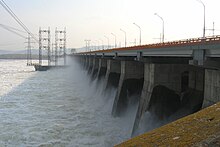Hydroelectricity in Russia

Hydropower is the most used form of renewable energy in Russia, and there is large potential in Russia for more use of hydropower. According to the International Hydropower Association Russia is the seventh largest producer of hydroelectricity in 2020. It is also second in the world for hydro potential, yet only 20% of this potential is developed.[1] Russia is home to 9% of the world's hydro resources,[2] mostly in Siberia and the country's far east. At the end of 2005, the generating capacity from hydroelectric sources in Russia was 45,700 MW, and an additional 5,648 MW was under construction. The World Energy Council believes that Russia has much potential for using its hydro resources, with a theoretical potential of about 2,295 TWh/yr, with 852 TWh being economically feasible.[3]
The largest dams in Russia are the Sayano-Shushenskaya Dam, which has an installed capacity of 6,400 MW; the Krasnoyarsk Dam (6,000 MW); the Bratsk Dam (4,500 MW); the Ust-Ilimsk Dam (4,320 MW) and the Zeya Dam (1,330 MW).[1] Some of the most recent dam projects are the Bureya Dam (2010 MW) and the Irganai Dam (800 MW). The Boguchany Dam (1920 MW), Zelenchuk Dam (320 MW), Zaramag Dam (352 MW) and Nizhne-Chereksky (60 MW) are currently under construction.[3] RusHydro is the largest hydroelectric company in Russia and the second largest hydroelectric producer in the world.[4] In October 2010, China Yangtze Power, the largest hydropower corporation in China, and EuroSibEnergo, a Russian energy company, signed a cooperation agreement to expand hydroelectric energy production in Russia and export energy to China's northern territories.[5] The West Siberian Generating Company has plans to start construction of eight mini-hydroelectric power plants in the Altai region before 2015.[6]
Largest hydropower plants
| Rank | Name | Capacity (MW) | Commissioning years | Owner | River | Region | Sources |
|---|---|---|---|---|---|---|---|
| 1 | Sayano-Shushenskaya | 6,400 | 1978-1985 2011-2014 |
RusHydro | Yenisei | Khakassia | [7] |
| 2 | Krasnoyarsk | 6,000 | 1967-1971 | EuroSibEnergo | Yenisei | Krasnoyarsk Krai | |
| 3 | Bratsk | 4,500 | 1961-1966 | EuroSibEnergo | Angara | Irkutsk Oblast | |
| 4 | Ust-Ilimsk | 3,840 | 1974-1979 | EuroSibEnergo | Angara | Irkutsk Oblast | |
| 5 | Boguchany | 2,997 | 2012-2014 | RusHydro / RUSAL | Angara | Krasnoyarsk Krai | [7] |
| 6 | Volga | 2,660 [8] | 1958-1961 | RusHydro | Volga | Volgograd Oblast | [7] |
| 7 | Zhiguli | 2,456 [9] | 1955-1957 | RusHydro | Volga | Samara Oblast | [7] |
| 8 | Bureya | 2,010 | 2003-2007 | RusHydro | Bureya | Amur Oblast | [7] |
| 9 | Saratov | 1,404 [10][11] | 1967-1970 | RusHydro | Volga | Saratov Oblast | [7] |
| 10 | Cheboksary | 1,374 | 1980-1986 | RusHydro | Volga | Chuvashia | [7] |
| 11 | Zeya | 1,330 | 1975-1980 | RusHydro | Zeya | Amur Oblast | [7] |
| 12 | Nizhnekamsk | 1,205 | 1979-1987 | Tatenergo | Kama | Tatarstan | |
| 13 | Votkinsk | 1,035 [12] | 1961-1963 | RusHydro | Kama | Perm Krai | [7] |
| 14 | Chirkei | 1,000 | 1974-1976 | RusHydro | Sulak | Dagestan | [7] |
Accidents
On 17 August 2009, there was an explosion at the Sayano-Shushenskaya hydroelectric power plant, which killed 75 plant workers and injured 13. The Federal Service for Ecological, Technological, and Nuclear Supervision's investigation concluded that poor management and technical flaws were responsible.[13] The explosion was caused by a 29-year-old turbine that experienced an uncontrolled and excessive vibration. Since then, officials from RusHydro, the operator of the plant, have called for better oversight and safety at hydroelectric plants.[13][14]
See also
References
- ^ a b "Hydropower in Russia". RusHydro. 2008–2009. Retrieved 28 January 2011.
- ^ "Russia". European Bank for Reconstruction and Development. 2010. Retrieved 23 January 2011.
- ^ a b "2007 Survey of Energy Resources" (PDF). World Energy Council 2007. 2007. Archived from the original (PDF) on 9 April 2011. Retrieved 23 January 2011.
- ^ "Russia appoints Sechin ally to manage hydro giant". Reuters. 23 November 2009. Retrieved 30 January 2011.
- ^ "Russia's EuroSibEnergo signs deal with China's hydro power corporation". RIA Novosti. 2 December 2010. Retrieved 26 February 2011.
- ^ "West Siberian genco to build 8 hydro-electric plants in Altai". RIA Novosti. 15 December 2010. Retrieved 26 February 2011.
- ^ a b c d e f g h i j "Установленная электрическая мощность электростанций и энергоустановок филиалов и ДЗО ОАО "РусГидро" по состоянию на 01.01.2015". Официальный сайт ОАО «РусГидро». Retrieved 2015-04-27.
- ^ "Волжская ГЭС увеличила установленную мощность в результате модернизации оборудования".
- ^ "Жигулевская ГЭС увеличила установленную мощность на 10,5 МВт".
- ^ "Мощность Саратовской ГЭС увеличена до 1403 МВт".
- ^ http://www.sarges.rushydro.ru/press/news/96946 .html
- ^ "На Воткинской ГЭС заменили первый гидроагрегат".
- ^ a b Joe Hasler (2 February 2010). "Investigating Russia's Biggest Dam Explosion: What Went Wrong". Popular Mechanics. Retrieved 6 December 2011.
- ^ "Report Lays Out Blame for Power Plant Explosion". The Other Russia. 29 December 2009. Retrieved 6 December 2011.
